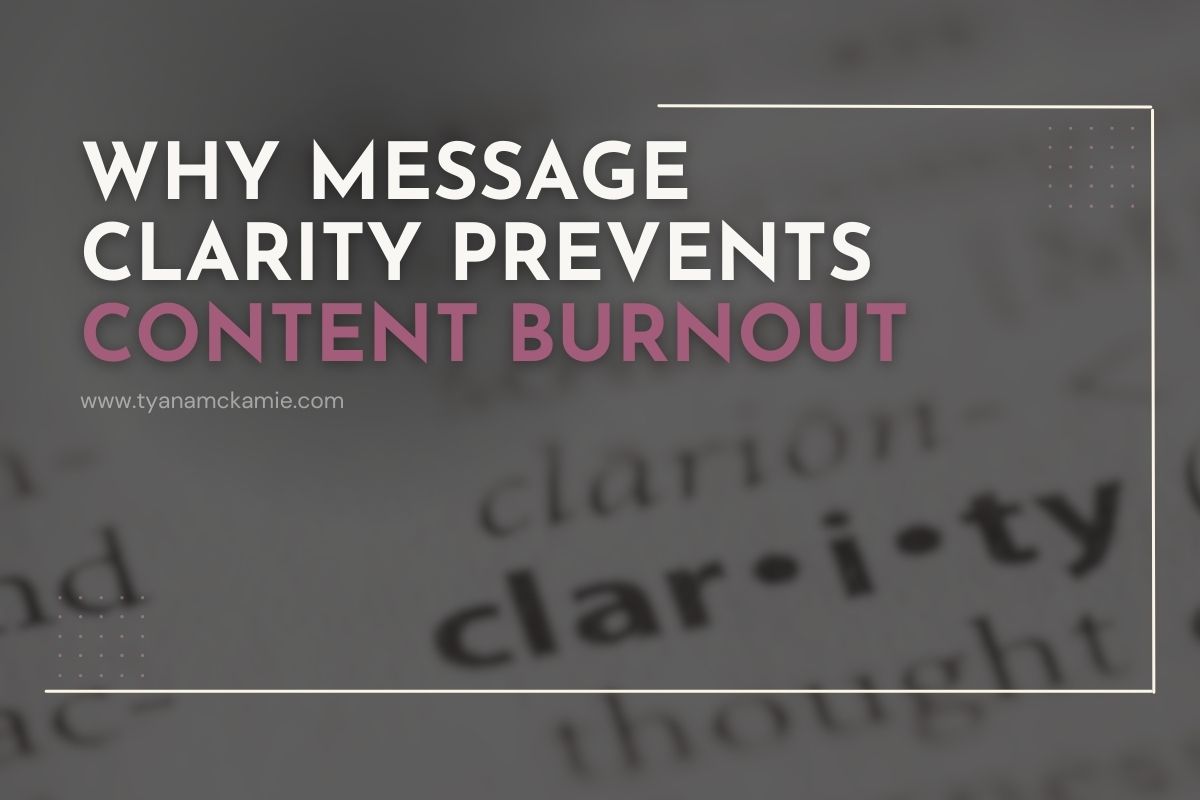The Message Clarity Blueprint That Prevents Content Burnout

You’re sitting at your computer, staring at a blank document, wondering what the hell you’re supposed to post today.
You’ve got a content calendar. You’ve got templates. You’ve even got a list of “proven” content ideas that supposedly work for everyone in your industry.
But here you are, three hours later, with nothing to show for it except a stress headache and the growing suspicion that you’re doing something fundamentally wrong.
The problem isn’t your content strategy. It’s what’s missing underneath it.
Why Most Content Strategies Lead to Burnout
Most entrepreneurs approach content creation like they’re feeding a hungry beast that demands fresh material every single day. They think the solution is more ideas, better templates, or a more detailed posting schedule.
But here’s what actually happens when you build content without message clarity:
You’re constantly recreating the wheel. Every post feels like starting from scratch because you don’t have a clear foundation to build from.
You second-guess everything. Without a clear message, you can’t tell if your content is working or not. Everything feels like a maybe.
You chase trends instead of serving your audience. When you don’t know what you stand for, you end up talking about whatever everyone else is talking about.
You sound like everyone else. Because you’re not sure what makes you different, you default to industry-standard language that says nothing.
This isn’t a productivity problem. It’s a clarity problem.
The Real Reason You’re Burning Out
Content burnout doesn’t happen because you’re creating too much content. It happens because you’re creating content without a clear message behind it.
Think about it: When you know exactly what you’re trying to say, content creation becomes a conversation, not a performance. You’re not fishing for ideas or wondering if this post will “work.” You’re simply sharing different angles of the same core message.
But when your message is unclear, every piece of content feels like a shot in the dark. You’re not building on anything solid. You’re just throwing content at the wall and hoping something sticks.
That’s exhausting.
The Message Clarity Blueprint
Message clarity isn’t about having the perfect elevator pitch. It’s about understanding three fundamental things:
1. What Problem Are You Actually Solving?
Not the surface problem. The real problem.
Your ideal client might say they need help with social media strategy. But what they actually need is confidence in their message so they can show up consistently without feeling like they’re performing.
Your ideal client might say they need better copy. But what they actually need is clarity on what makes them different so they can stop sounding like everyone else.
The surface problem is what brings them to you. The real problem is what keeps them working with you.
2. What Change Are You Creating?
This isn’t about what you do. It’s about what shifts when someone works with you.
Are you helping them go from scattered to focused? From invisible to magnetic? From overwhelming to effortless?
The transformation you create is your message. Everything else is just tactics.
3. What Do You Believe That Others Don’t?
This is your differentiator. Not your unique process or your special framework. Your unique perspective on the problem.
Maybe you believe that authenticity without strategy is just oversharing. Maybe you believe that templates are the enemy of true connection. Maybe you believe that your astrology birth chart holds the key to your natural content style (it does 😉).
Whatever it is, this belief should show up in everything you create.
How to Build Content That Writes Itself
Once you have clarity on these three things, content creation becomes completely different.
Instead of asking “What should I post today?” you ask:
- How can I help someone understand the real problem they’re facing?
- What angle of the transformation haven’t I explored yet?
- How can I share my unique perspective in a way that challenges conventional thinking?
Every piece of content becomes a different facet of the same core message. You’re not starting from scratch each time. You’re building on a foundation.
The Content Strategy That Actually Prevents Burnout
Here’s what changes when you lead with message clarity:
Your content has a point. Every post connects back to your core message. Nothing feels random or forced.
You stop second-guessing yourself. When you know what you stand for, you can easily tell if a piece of content aligns with your message or not.
You develop a natural content rhythm. Instead of forcing yourself to post on a schedule, you post when you have something valuable to add to the conversation.
Your audience knows what to expect. They come to you for a specific perspective, not just general industry advice.
You sound like you. Because you’re clear on your message, your personality comes through naturally instead of feeling performed.
The Psychology Behind Why This Works
Your brain is wired to look for patterns. When you don’t have a clear message, your brain has to work overtime to figure out what to say and how to say it every single time.
But when you have message clarity, your brain can focus on execution instead of creation. You’re not deciding what to talk about. You’re deciding how to talk about it.
This is why some entrepreneurs can create content effortlessly while others burn out after a few weeks. It’s not about their capacity or their creativity. It’s about their clarity.
How to Find Your Message (Without Overthinking It)
Step 1: Analyze Your Best Client Conversations
Look at the moments when potential clients said “finally, someone who gets it.” What were you talking about? What problem were you addressing? What perspective were you sharing?
These moments reveal your natural message. You don’t need to create it. You need to recognize it.
Step 2: Notice What You Repeatedly Explain
What do you find yourself saying over and over again? What misconceptions do you constantly correct? What obvious things do people seem to miss?
Your message is often hiding in the things you think everyone already knows.
Step 3: Identify Your “Yeah, But” Responses
When you hear typical industry advice, what’s your automatic response? When someone shares a popular opinion, what do you want to add?
Your unique perspective lives in your disagreements with conventional wisdom.
What to Do Next
- Stop creating content for one week. Use that time to get clear on your message instead.
- Write down your answers to the three core questions: What problem are you solving? What change are you creating? What do you believe that others don’t?
- Test your message in real conversations. Does it resonate? Does it feel authentic? Does it differentiate you?
- Create a content filter. Before you post anything, ask: “Does this support my core message or am I just filling space?”
- Start small. Pick one platform and focus on consistency over quantity. Better to post once a week with clarity than daily without purpose.
The Truth About Content Strategy
You don’t need more content ideas. You need more message clarity.
When you’re clear on what you’re trying to say, the content creates itself. When you’re unclear, no amount of templates or frameworks will save you.
Your message is already there. You just need to stop creating long enough to hear it.
Tired of second-guessing every post? Book a 15-minute call and let’s see how I can help you get clear on your message.


